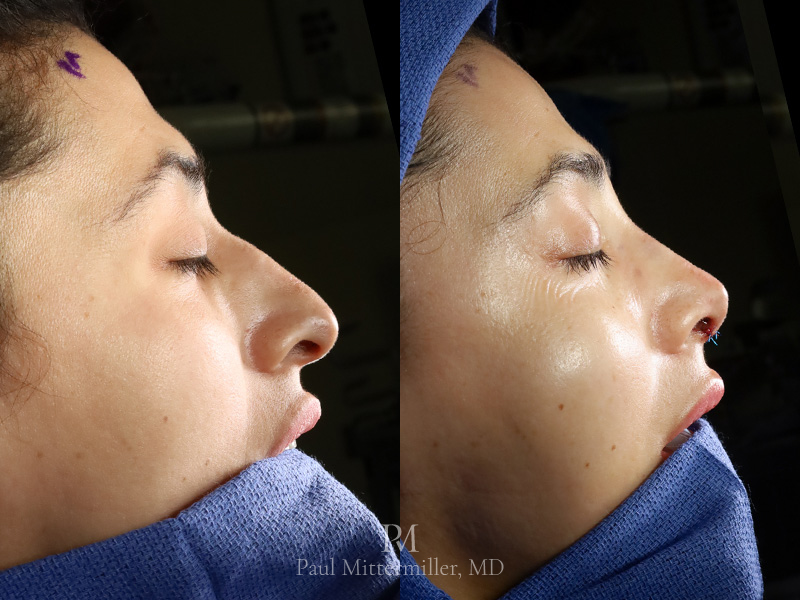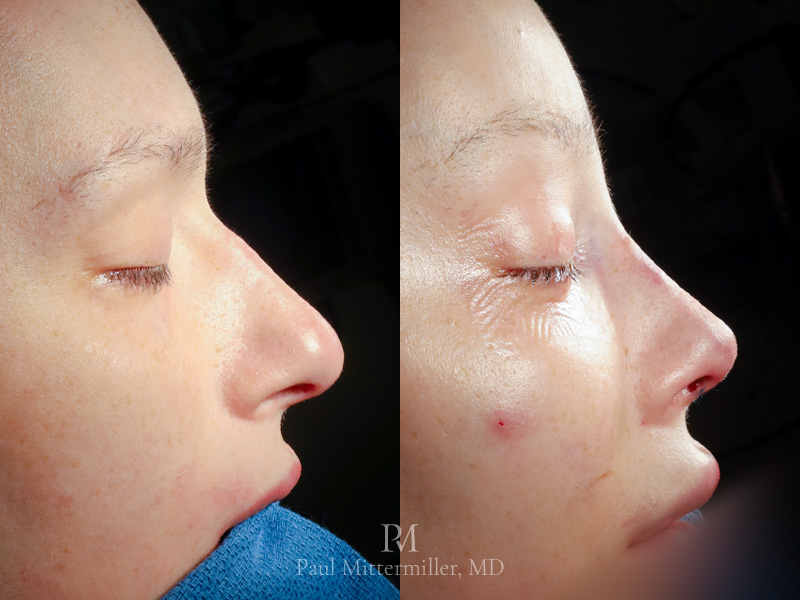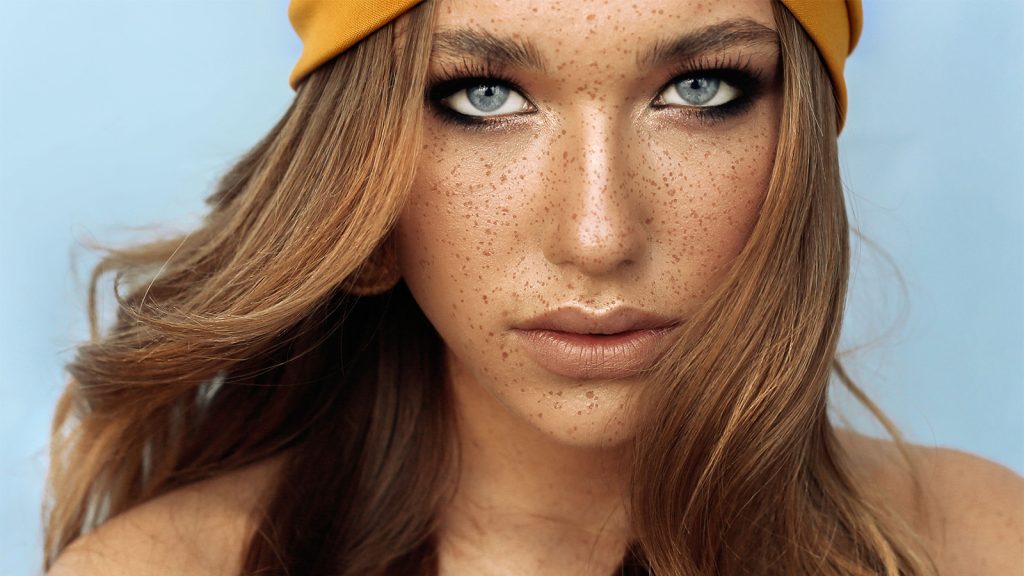
Rhinoplasty Los Angeles – Rhinoplasty LA
There are many aspects of rhinoplasty that contribute to function and aesthetics. Functionally, rhinoplasty can require a septoplasty, or correction of the internal or external nasal valves. A cosmetic rhinoplasty often focuses on changing the overall size and shape. The goal is to perfect the small intricacies of nasal appearance. It is important to know some general information about rhinoplasty in order to find the best rhinoplasty surgeon in Los Angeles, California. It can be helpful and interesting to learn about rhinoplasty before undergoing nasal surgery so that you have a better understanding of how your facial appearance is being changed with surgery.
- Rhinoplasty Los Angeles – Rhinoplasty LA
- Rhinoplasty with Dr. Paul Mittermiller
- Introduction to rhinoplasty
- Cosmetic rhinoplasty
- Functional rhinoplasty, or septorhinoplasty
- Techniques for performing a rhinoplasty
- Recovery after open rhinoplasty
- Recovery after closed rhinoplasty
- Postoperative recommendations
- Frequently asked questions
- Is a rhinoplasty permanent?
- What is an ethnic rhinoplasty?
- What is a feminizing rhinoplasty?
- How much does it cost to have a rhinoplasty in Los Angeles?
- What is a finesse rhinoplasty?
- What is a liquid rhinoplasty, or nonsurgical rhinoplasty?
- Is Los Angeles the best place to have a rhinoplasty?
- How do I find the best rhinoplasty surgeon near me in Los Angeles, California?
- References
Rhinoplasty with Dr. Paul Mittermiller
About Dr. Mittermiller
Dr. Mittermiller is a plastic surgeon with specialty training in craniofacial surgery. He attended Yale University as an undergraduate and went on to study medicine at the University of California, San Francisco. Since college, he has been fascinated with surgical operations involving the structures of the face and has been pursing this passion since that time. Following medical school, he completed his residency training at Stanford Hospital and went on to a craniofacial surgery fellowship at New York University.
Dr. Mittermiller cares deeply about his patients and wants to provide them the best rhinoplasty Los Angeles can offer. He is attentive to his patients and cares about getting them a nose that provides them with the best functional outcome and an appearance they desire. Dr. Mittermiller works in Los Angeles, California.
Dr. Mittermiller’s philosophy for rhinoplasty
Dr. Mittermiller is primarily focused on obtaining the best rhinoplasty result for each patient that appears natural and functions well. He prefers to create a nose that appears natural, yet refined. Patients will often present to Dr. Mittermiller with specific concerns about either the function or appearance of their nose. He works with all his patients to understand their aesthetic goals while helping them either maintain or obtain a clear nasal passage.
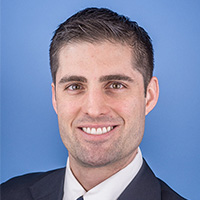
Dr. Mittermiller is a plastic surgeon with fellowship training in craniofacial surgery. He frequently sees patients interested in improving the appearance or function of their nose.
Contact us today for a consultation.
Introduction to rhinoplasty
What is a rhinoplasty, or “nose job”?
A rhinoplasty, or nose job, is a surgery that is performed on the nose. The word rhinoplasty originates from Greek terms and essentially means a surgery on the nose. Not all rhinoplasty surgeries are performed entirely to change the appearance of the nose. There are many maneuvers that can be performed during a rhinoplasty that are performed to improve air flow through the nose.
What is a cosmetic rhinoplasty or aesthetic rhinoplasty?
A cosmetic rhinoplasty or aesthetic rhinoplasty is a type of nose surgery that primarily focuses on changing the appearance of the nose. A cosmetic rhinoplasty is commonly referred to as a “nose job.” There are many different types of noses and there are many preferences for nose shapes. The nose has multiple areas that are commonly changed to fit aesthetic ideals. These will be discussed later. The best nose job seeks to address areas of concern for the patient while maintaining a natural appearance.
What is a functional rhinoplasty?
A functional rhinoplasty describes a type of nose surgery that is performed with the primary goal of improving air flow through the nose.
What is a combined cosmetic and functional rhinoplasty?
A combined functional and aesthetic rhinoplasty is one in which there are functional components to improve air flow through the nose and aesthetic components to change the appearance of the nose.

Cosmetic rhinoplasty
A cosmetic rhinoplasty is what people usually think about when they want a “nose job.” A cosmetic rhinoplasty is performed to change the appearance of one’s nose. There are many shapes of noses and there are many desirable nose shapes. Common desires include having a dorsal hump reduction, undergoing a feminizing rhinoplasty, narrowing a bulbous tip, creating a pointier tip, or creating a more upturned tip. This section will discuss the different areas of the nose that people commonly want to address with a cosmetic, or aesthetic rhinoplasty. The best rhinoplasty aims to address a patient’s concerns while maintaining a natural appearance.
Nasal dorsum
The nasal dorsum is commonly viewed from the side profile. People most commonly want to change the shape of their nasal dorsum if they have a dorsal hump, or bump, or if they do not have a tall enough nasal dorsum.
Dorsal hump reduction
A dorsal hump reduction is performed for people who have a bump on their nose when seen in the side or profile view. The complexity of the operation often directly correlates with the size of the bump.
Dorsal augmentation
Nasal dorsum augmentation is performed for people who have minimal height of the nasal dorsum. Augmentation of the nasal dorsum can be performed through multiple techniques during a rhinoplasty, or “nose job.” The most common techniques involve the use of cartilage or implants.
Cartilage – When cartilage is used, it can be acquired through different methods. Two common methods for acquiring cartilage for dorsal augmentation is by using one’s own rib cartilage or by using cadaveric, or donor, cartilage. The best nose job augmentation material depends on patient preferences, surgeon preferences, and the degree of augmentation. Cartilage has the advantage of being the material most biocompatible with the body. It more readily incorporates with a patient’s native nasal tissue. The disadvantage of using cartilage for dorsal augmentation is that it can warp or dissolve. If this occurs to a significant degree, it often requires a revision rhinoplasty.
Nasal implants – These implants are often made from silicone and can be made from other materials such as porous polyethylene. Implants have the advantages of being easily, readily available. They have predefined shapes that are reproducible and often match aesthetic ideals. The disadvantage of using implants is that due to their inability to completely incorporate into the native nose tissue and they can damage the overlying skin. If the damage to the overlying the skin is great enough, the implant may need to be removed and the damaged tissues need to be repaired. The implant is often extends from the root of the nose to a location underneath the cartilages at the tip of the nose.1 These implants usually range from 2-7mm in thickness.
Nasal tip shape
People have many shapes to their nasal tips. The terms that are commonly seen are boxy or bulbous nasal tips. Many Los Angeles rhinoplasty surgeons focus on creating an optimal nasal tip shape. The best nose job surgeons are able to modify the nasal tip shape in a variety of ways.
Boxy nasal tip
A boxy nasal tip is one that has a boxy, or square shape when viewed from the undersurface.
Bulbous nasal tip
A bulbous nasal tip is one that is wide and has a rounded appearance when seen from underneath.
Pinched nasal tip
People can develop abnormal nasal tip shapes following a rhinoplasty. A common problem that occurs after a rhinoplasty is a “pinched” nasal tip. The occurs when the tip of the nose is made too tight or small and appears as though it has been pinched together.
Improving tip shapes
Addressing the nasal tip with surgery is performed by changing the shapes of the cartilages that form the tip of the nose. Addressing the tip is a common request with a “nose job.” This is done by changing the amount of cartilage in that area and changing the shape of the cartilages. The shapes of the cartilages are modified with sutures or cartilage grafts.
Nasal tip location
The location of the nasal tip dramatically changes the appearance of one’s nose and face. The tip can be too high, too low, too close to the face, or too far from the face.
Upturned nose
A nose may appear too upturned when the tip is too high in relation to the rest of the nose. Some people find a small degree of nasal tip rotation, or upturning, to be attractive. Too much upturning of the nose can result in an abnormal appearance that some refer to as a “piggy nose” or “pixie nose”.
Droopy nasal tip
A droopy nasal tip or ptotic nasal tip occurs when the tip of the nose is too low in relation to the rest of the nose and the face. This can occur with age or it can result as the result of a prior rhinoplasty. Correction of a droopy nasal tip often requires repositioning of the tip and can involve additional more complicated techniques.
Underprojected nose
An underprojected nose is one in which the nasal tip is too close to the surface of the face.
Overprojected nose
An overprojected nose in one in which the nasal tip is too far from the surface of the face.
Nasal width
The width of the nose can be adjusted higher up on the nose where the nasal bones are located, or lower on the nose where the nasal alae are located. The width of the nose at the upper portion can be adjusted by breaking, or fracturing the bones in this location. The width of the nose at the lower portion is often adjusted by performing an alar base reduction.
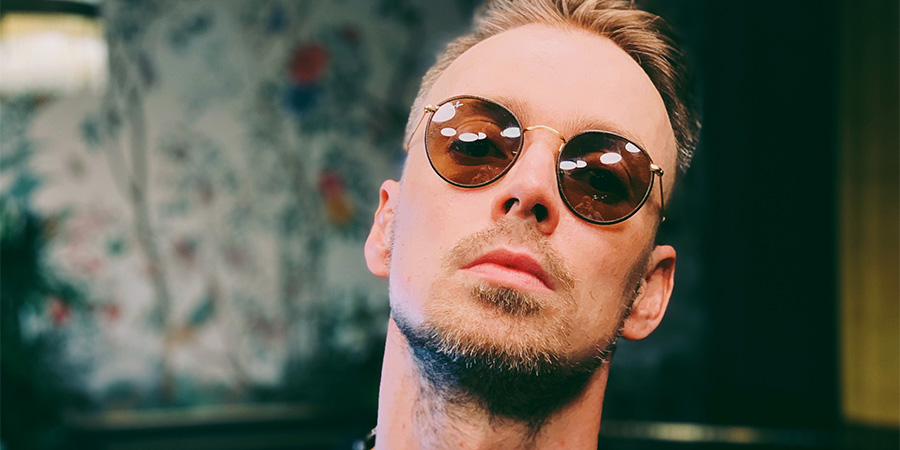
Functional rhinoplasty, or septorhinoplasty
There are multiple areas that cause obstruction of air flow through the nose. In general, these include the external nasal valve, internal nasal valve, septum, and turbinates. People have nasal obstruction due to problems that can occur at one or more of these locations. People frequently use the term septorhinoplasty to refer to a functional rhinoplasty. A septorhinoplasty is one that modifies the septum while also changing the outside appearance of the nose. This is different from an isolated septoplasty, which does not change the appearance, or a rhinoplasty that does not address the septum. The best Los Angeles septorhinoplasty surgeons frequently focus on achieving a symmetric nose that functions well.
Septum
A deviated septum is one of the causes of nasal obstruction that is most often talked about. The septum is a structure in the middle of the nose that ideally should lie directly in the midline of the nasal cavity. Due to abnormal growth or trauma, the septum can become deviated. When this happens, the deviation off to one side results in obstruction of air through that side.
A septoplasty can be performed through a variety of different techniques. If the deviation is deep within the nasal cavity, the septoplasty can be performed with incisions that are placed only on the inside of the nose (no external incisions). If the deviation is towards the front of the nose where it is visible to other people, it may be necessary to place an incision underneath the nose to perform a septoplasty that corrects the deviation. After the visible portion of the deviated septum is exposed, there are multiple septoplasty techniques for improving the appearance of the deviated septum.
Turbinates
The turbinates are structures within the nose that normally function to warm and humidify the air as it passes through the nose. These can become enlarged, or hypertrophied, and cause an obstruction within the nose. The turbinates also swell with allergies and when this happens, the airway can become obstructed.
There have been multiple methods for treating turbinate hypertrophy. One of the more commonly used methods is to remove the core of the turbinate through a “submucous turbinate resection”. This helps to reduce the size of the turbinate while retaining some of its function. Historically, some people completely removed the inferior turbinates, but this led to other problems such as empty nose syndrome, which can be extremely difficult to treat.
Another method for turbinate reduction is through radiofrequency treatment of the turbinate. This causes the tissue to contract and decreases the amount of swelling that occurs when one is reacting to allergens.
Internal nasal valve
The internal nasal valve is a difficult anatomic feature to visualize when discussing levels of nasal obstruction. Most people are not looking that far up into other people’s noses or their own noses! The images below demonstrate the locations of the internal and external nasal valves. As you can see, the internal nasal valve lies at the junction between the lower lateral cartilages (cartilages that are lowest on the nose) and the upper lateral cartilages (second set of cartilages higher up on the nose).
The internal nasal valve forms a triangular shaped opening that can become narrow or collapse during inspiration. When this happens, one feels as though there is an obstruction of air through the nose.


External nasal valve
The external nasal valve is the entrance into the nose. This is the outer part of the nostrils. People can have narrow nostrils that collapse when they breathe forcefully through the nose or they can have one nostril that is smaller than the other. Asymmetry of the nostrils is commonly due to a deviation of their septum at the lower part of the nose. It can also be due to prior rhinoplasty procedures.
There are multiple techniques for strengthening the external nasal valve. One common technique is to place small cartilage grafts into the rims of the nostrils.
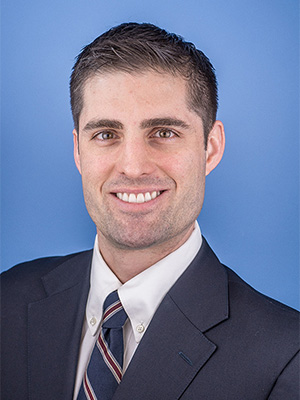
Dr. Mittermiller is a specialty trained plastic surgeon who primarily operates in the Los Angeles area. He is passionate about craniofacial surgery, gender-affirming surgery, and rhinoplasty.
Click here to learn more about Dr . Mittermiller
or
Contact us today to schedule a consultation.
Techniques for performing a rhinoplasty
Open rhinoplasty
An open rhinoplasty is one that is performed by creating an incision on the outside of the nose. The incision is placed underneath the nose in the middle portion of the columella. The columella is the anatomic structure that separates the nostrils.
Closed rhinoplasty
A closed rhinoplasty is one that is performed through incisions that are located only on the inside of the nose. This type of approach to rhinoplasty can be nice for some patients since it results in a faster healing time and does not leave any external scars. This type of approach is commonly considered to be significantly more difficult for creating reliable changes to the shape of the tip of the nose. It can be extremely helpful for someone who is concerned about scarring after rhinoplasty.
Most surgeons do not offer this to all their patients. A closed rhinoplasty approach is not offered when the surgeon thinks he can achieve a better result using an open rhinoplasty approach. The best rhinoplasty approach depends on the patient’s preferences, the desired changes for the nose, and the surgeon’s preferences.
Recovery after open rhinoplasty
Splinting after rhinoplasty
Splints are commonly used after a rhinoplasty to protect the nose, maintain the shape of the nose, and secure the position of various nasal structures such as the nasal bones or septum. External splints are placed on the outside of the nose and internal splints are placed within the nostrils.
Patients undergoing a rhinoplasty, or “nose job,” do not always receive both types of splints. Sometimes both types are used, sometimes only an external splint is used, sometimes only internal splints are used used, and sometimes no splints are used. The choice of which splints are used depends on surgeon preferences and the details of the individualized surgery that is being performed. The best nose job surgeons in Los Angeles will review the splints with you during your consultation and discuss why they are or are not being used in your situation.
Pain after rhinoplasty
Pain and discomfort following a rhinoplasty is usually well managed with oral medications alone. The nose can be quite tender following the surgery, so one should be careful to avoid trauma to the nose or inadvertently bumping the nose. People usually take oral narcotic pain medications for less than one week before transitioning to only acetaminophen or ibuprofen. Sometimes the pain has decreased to a point where they require no pain medications within the first week.
Swelling after rhinoplasty
The nose will be swollen immediately following a rhinoplasty. The most significant swelling occurs during the first 1-2 weeks. After this time, the swelling starts to reduce rather dramatically over the first 1-2 months. It can frequently take 1-2 years before all residual swelling dissipates from the nose. Surgeons will sometimes ask patients to continue taping their nose after splint removal to help manage the swelling.
Bruising after rhinoplasty
The amount of bruising one experiences following a rhinoplasty can be extremely variable. Some patients have no bruising, whereas others can have quite visible bruising. When bruising does occur, it is often most prominent and visible around the lower portions of the eyes. When this happens, it can last 1-2 weeks before resolving.
Scarring after rhinoplasty
The scarring that occurs after a rhinoplasty is entirely dependent on the incisions that were created during the surgery. With a closed rhinoplasty, the incisions are placed within the nostrils and will not be visible after the operation. During an open rhinoplasty, an incision is created on the undersurface of the columella, which is the anatomic structure between the nostrils. This incision normally heals very well and is frequently very difficult to see at conversational distances.
When an alar base reduction is performed, incisions are created at the bases of the nose. These can produce the most visible scarring, but when performed correctly, they are hidden at the natural junction between nose and the face. The incisions are often slightly red after surgery and, in worst case scenarios, can remain this way for multiple months. The redness almost always resolves with time.
Recovery after closed rhinoplasty
The recovery from a closed rhinoplasty is usually much easier than the recovery from an open rhinoplasty. To start, there are no visible incisions on the outside of the nose with a closed rhinoplasty, so there will be no visible wounds or scars. There are incisions on the inside of the nose that will take time to heal. These incisions can have oozing for the first few days after the surgery, which is normal. The amount of swelling after a closed rhinoplasty is usually significantly better than from an open rhinoplasty since there are more pathways for fluid to leave the nose.
The amount of pain and bruising from a closed rhinoplasty is similar to that of an open rhinoplasty. The amount of pain often has to do with how extensive the changes were from the procedure. Bruising is also often related to the types of procedures performed, including whether there was a large dorsal hump reduction and whether the nasal bones required fractures.
Postoperative recommendations
Activity after rhinoplasty
It is usually recommended to avoid strenuous activities in the immediate postoperative period since this can cause injury to the nose or increase the risk of bleeding. It is usually recommended to continue gentle activities such as standing, sitting, and walking. Depending on the degree of structural changes to the nose, it may be recommended to avoid activities that can involve high energy impacts to the nose for multiple months postoperatively.
Bandages after rhinoplasty
Dr. Mittermiller will often place a piece of gauze underneath the nose, particularly if a septoplasty was done or turbinate reductions were performed. Following those procedures, people often have oozing from the nose for a few days after surgery. A piece of gauze underneath the nose can help absorb any discharge from the nose. It is often easiest to simply hold this piece of gauze in place with a long piece of tape that secures the gauze to the cheeks. The gauze and tape can be replaced as often as necessary to keep the area clean.
Splint care after rhinoplasty
Patients may have a plastic splint placed on the nose or silicone splints placed within the nose at the completion of a rhinoplasty operation. These splints should remain in place until the first postoperative appointment. No special care is usually necessary for these splints. One should avoid trying to get them wet and should avoid trying to remove them.
Bathing after rhinoplasty
Bathing is allowed and recommended after a rhinoplasty. If a splint has been placed, it is important to prevent water from touching the external splint since this could cause the splint to loosen or fall off. It can be difficult to wash one’s hair, but it is possible to shower without having water touch the splint. After the splint has been removed, water may gently flow over the nose while bathing. It is often recommended to not aggressively scrub the outside of one’s nose, since the inside components are still healing.
Sleeping after rhinoplasty
Sleeping with one’s head elevated can help reduce swelling and pain of the nose following surgery. People often sleep with their head elevated by using a wedge pillow, by creating a ramp of stacked pillows behind the head and back, or by sleeping in a recliner.
When major reconstruction of the nose or septum has been performed during a rhinoplasty, it can be best to avoid sleeping on your side or on your stomach. This will prevent any injury to the reconstructed areas of the nose.
Swelling after rhinoplasty
Following the procedure, there will often be significant swelling of the nose. Placing ice around your nose (cheeks, forehead) for the first 2 days after the operation can help reduce bruising and swelling.
Scar care after rhinoplasty
As mentioned previously, the scars from a rhinoplasty often heal very well. After the sutures are removed, vaseline or antibiotic ointment can be placed on the incision once or twice daily until there are no scabs. Once the scabbing has subsided, over-the-counter scar creams such as silicone-based scar creams can be helpful to further minimize scarring. Sunscreen on the incisions can help prevent pigmentation abnormalities.
Nasal sprays after rhinoplasty
Dr. Mittermiller often prescribes two types of sprays after rhinoplasty. These are Afrin (oxymetazoline) and a saline spray.
The Afrin spray can be helpful if there is bleeding from within the nose by constricting the blood vessels. If patients feel the need to use this spray, they should contact the surgeon to help assess the situation.
The saline spray can be helpful to manage crusting and dryness within the nose. This spray can be used starting 2-3 days after surgery and is often helpful for the first few weeks following surgery. There is frequently dried blood and mucus within the nostrils following surgery and the saline spray can help to loosen this material and clean the airway.
One should NEVER pick at the inside of the nose immediately following a rhinoplasty. If there are concerns, patients should contact their surgeon.
Ointments following rhinoplasty
Certain ointments can be helpful for healing following a rhinoplasty. Commonly used ointments are Vaseline or Aquaphor. These are petroleum-based ointments that keep the nose lubricated and assist with wound healing. These should only be used after recommendation by the surgeon. This often starts after the first postoperative appointment. Patients can place a small amount of ointment on a cotton-tipped applicator, such as a Q-tip, and gently rub the ointment around the inside of the nares.
Frequently asked questions
Is a rhinoplasty permanent?
A rhinoplasty, or “nose job,” produces lasting alterations to the nose. The human body continues to change as it ages, so the nose will continue to age with the rest of the body. It is important for the best rhinoplasty surgeons to create changes of the nose that will maintain their support as the body ages.
What is an ethnic rhinoplasty?
An “ethnic” rhinoplasty is an unfortunate ethnocentric term that is frequently used to describe rhinoplasties that are performed on people with ethnic backgrounds that are not white, or Caucasian. There exist generalized notions about the normative shape of each ethnic group.
It is important for the best rhinoplasty surgeons to understand the anatomic differences that commonly exist between these ethnic groups to create a nose that is pleasing to the patient while not trying to create a nose that is considered “ideal” in only one ethnic group.
African American Rhinoplasty
There are many ethnic groups and trying to create a distinction at any level is difficult. Africa is a massive continent and there is tremendous variation within the noses of people who lie on this continent. The term African American is overly broad, but there are commonly some features that differ between the African American nose and the caucasian nose.
A recent study out of South Africa attempted evaluated facial measurements of the young Black South African woman.4 In this study, they note a few conclusions. They state that the nose is generally flatter, with a more obtuse nasofrontal angle and less nasal tip projection. They noticed a wider nasal base width and more acute nasolabial angle (less rotation) compared to caucasian individuals.
What is a feminizing rhinoplasty?
A feminizing rhinoplasty is one that focuses on enhancing the feminine features of a nose. This often involves reducing the dorsum of the nose or increasing the amount of nasal tip rotation, meaning the degree the nose is upturned.5 The key aspects to a feminizing rhinoplasty is to focus on specific features of the nose while maintaining a natural appearance. A feminizing rhinoplasty can be performed in isolation or as part of a larger facial feminization surgery (What is facial feminization surgery?). A feminizing rhinoplasty can be performed on cisgender, transgender, and non-binary individuals.
How much does it cost to have a rhinoplasty in Los Angeles?
The cost of an LA rhinoplasty is extremely variable. Some people want only minor changes to their nose while others are looking for a dramatic change to multiple areas of the nose. Some patients want only a cosmetic rhinoplasty and some patients only want a rhinoplasty that addresses the function of their nose. Many patients want a rhinoplasty that improves the function and appearance of their nose. Simpler rhinoplasties understandably will cost less than complicated rhinoplasties. Secondary, or revision rhinoplasties often cost more due to the increased difficulty and complexity of these operations.
Insurance companies sometimes cover portions of a rhinoplasty when there is a functional component being performed to improve nasal breathing. When insurance is involved, it covers only the portions of the rhinoplasty that are being performed to improve breathing. Additional work designed to improve the appearance of the nose is paid for out-of-pocket.
The price of a cosmetic rhinoplasty Los Angeles depends on multiple surgeon-specific factors. The cost varies depending on the city where the operation is being performed, the individual price schedules created by the surgeons, the variable costs of the facility where the surgery is being performed, and the costs incurred by the anesthesiologists assisting with the case.
According to a 2021 article by RealSelf that was updated in 2022, the average cost of a rhinoplasty is $7,750 with a range from $1,800 to $13,725 according to reviews by members.6 That survey being noted, the cost of rhinoplasty has been reported to be as high as $30,000.7 The low end of this range may be comprised of functional rhinoplasties that are being entirely covered by insurance. In scenarios such as this, the purpose of these rhinoplasties is only to improve nasal breathing.
What is a finesse rhinoplasty?
A finesse rhinoplasty is one that focuses on very specific, directed changes to the nose. It leaves the majority of the shape of the nose unchanged and changes the appearance of the nose in only a few small areas.
What is a liquid rhinoplasty, or nonsurgical rhinoplasty?
A liquid rhinoplasty, or nonsurgical rhinoplasty, is one where the surgeon uses filler to create changes to the appearance of the nose. Click here for more information on a nonsurgical rhinoplasty.
Is Los Angeles the best place to have a rhinoplasty?
Los Angeles is a great city to have a rhinoplasty. There is an extremely high number of plastic surgeons who perform rhinoplasty in Los Angeles, which means patients are able to find the best rhinoplasty surgeon for them. People who live in Los Angeles have access to this high number of surgeons and people who travel into Los Angeles will be able to enjoy the many amenities of the city and enjoy the weather, which is pleasant year-round. An LA rhinoplasty is a great option for locals and visitors.
How do I find the best rhinoplasty surgeon near me in Los Angeles, California?
It is important for patients to learn about surgeons and their backgrounds. It is important for patients to know the type of training their surgeon has undergone and how much of the surgeon’s practice is focused on rhinoplasty. Patients should feel comfortable enough with their surgeons to explain their desired functional and cosmetic outcome.
References
- Kwan E, Truong A, Park J (2025) Thirty-Year Experience in Augmentation Rhinoplasty Using Silicone Implants: A Safer, Cheaper, Faster, and More Effective Technique. Aesthet Surg J 45 (9):887–892. doi:10.1093/asj/sjaf102 https://www.ncbi.nlm.nih.gov/pubmed/40498860
- Bloching MB (2007) Disorders of the nasal valve area. GMS Curr Top Otorhinolaryngol Head Neck Surg 6:Doc07. https://www.ncbi.nlm.nih.gov/pubmed/22073083
- Bloching MB (2007) Disorders of the nasal valve area. GMS Curr Top Otorhinolaryngol Head Neck Surg 6:Doc07. https://www.ncbi.nlm.nih.gov/pubmed/22073083
- Wilson SP, Medapati V, Segwapa K (2023) Facial Anthropometric Norms of the Young Black South African Woman. Plast Reconstr Surg Glob Open 11 (4):e4942. doi:10.1097/GOX.0000000000004942 https://www.ncbi.nlm.nih.gov/pubmed/37124387
- Bannister JJ, Juszczak H, Aponte JD, Katz DC, Knott PD, Weinberg SM, Hallgrimsson B, Forkert ND, Rahul Seth (2022) Sex Differences in Adult Facial Three-Dimensional Morphology: Application to Gender-Affirming Facial Surgery. Facial Plastic Surgery and Aesthetic Medicine 24 (S2):S24–S30. doi:10.1089/fpsam.2021.0301 https://pubmed.ncbi.nlm.nih.gov/35357226/
- How Much Does a Rhinoplasty Cost? (2022). https://www.realself.com/surgical/rhinoplasty/cost. Accessed 8/5/22 2022
- How Much Does a Rhinoplasty Cost? (2022). https://www.realself.com/surgical/rhinoplasty/cost. Accessed 8/5/22 2022



